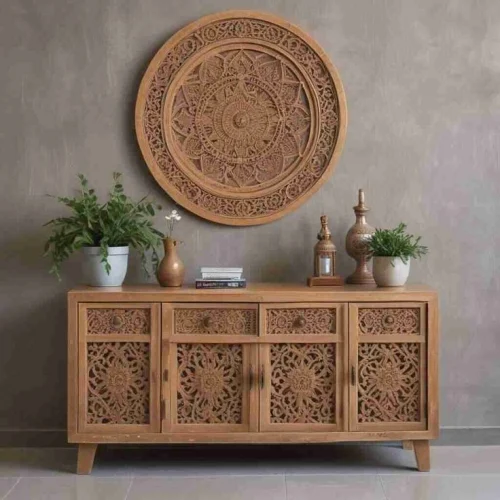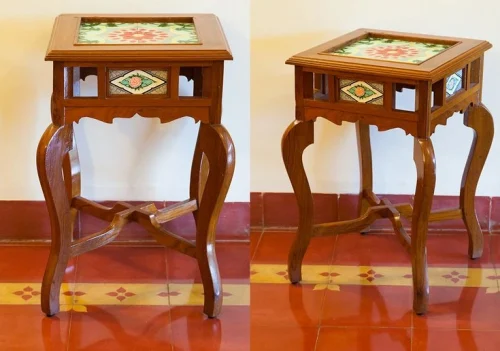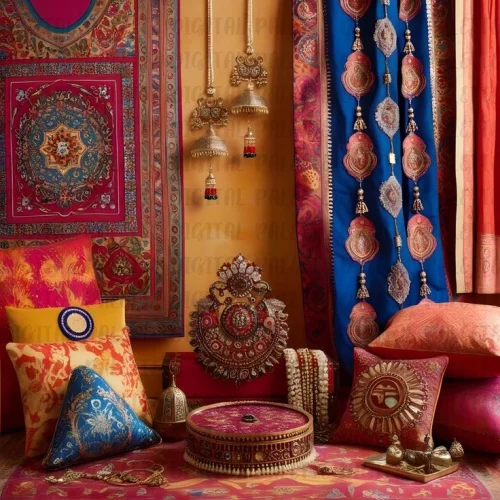
Top 10 Traditional Interior Designs Used In Indian History
August 2, 2025
Top 5 House Warming Ceremony Rules for Indian Homes in 2025
August 2, 2025I didn’t grow up in a home full of antique furniture, but every time I stepped into someone’s traditional South Indian house—usually my grandparents’ friends or distant relatives—I’d find myself just standing still, staring. The wooden chairs were different. The cupboards had brass handles. Even the doors seemed to have a history.
And over time, I realised something: it’s not just about having “old furniture.” It’s about warmth. Weight. Texture. This whole vibe has a name—and it’s something more people are starting to fall in love with again: the South Indian wooden furniture style.
Now, before you go thinking you need a palatial Chettinad bungalow to pull it off, let me stop you right there. You can bring this look into even a small city apartment if you get the basics right. And no, you don’t have to spend a fortune.
Let’s talk about how.
Table of contents
What Is South Indian Wooden Furniture Style?

If I had to describe it in one word? Honest.
It’s not minimal. Not sleek. Definitely not factory-made. This is the kind of furniture that has curves, carvings, chunky legs, and stories carved into it. You’ll see it in homes across Tamil Nadu, Kerala, Karnataka, Andhra… but the overall feeling is the same: solid wood, rich finishes, handcrafting that wasn’t rushed.
A few things that stand out:
- Teak and rosewood—the real stuff, not laminates pretending to be wood
- Ornate carvings, often floral, temple-inspired, or geometric
- Low seating (because back then, people actually sat closer to the floor!)
- Big cupboards, pooja units, or divans that feel like they’ve seen 3 generations
And yes, if you’ve heard of Chettinad furniture designs, those are a big part of this look too. I’ll get to them in a second.
Start with Just One Piece
I know it’s tempting to go full-on traditional once you fall in love with this style. But unless you’re doing a total home makeover, my advice? Start with one piece. Just one.
Something like:
- A carved wooden armchair (especially those with cane seats)
- A console table in the entryway
- A swing (yes, the classic oonjal!) for your living room
- A pooja cabinet with tiny pillars on the sides
That one piece—if you pick it right—will do all the talking. You don’t need ten. And when you walk into the room, it’ll quietly grab attention without screaming for it.
What Colours Actually Work?
Here’s the thing: South Indian wooden furniture is usually dark—teak brown, deep mahogany, that reddish rosewood tint. If your walls and decor are already dark, it can get overwhelming.
So what do you do?
Go for contrast. Keep the walls simple—off-white, light beige, or even pale mustard or earthy pink if you’re feeling bold. If your flooring is modern tile or marble, let it be. The mix actually works better than you’d think.
And add plants. Nothing brings out the beauty of carved wood better than a tall areca palm or a bunch of tulsi in a brass pot.
The Chettinad Charm (And Why It's So Loved)

Let’s talk about Chettinad for a second.
Chettinad furniture designs are basically the royalty of South Indian decor. They’re heavy, detailed, and often made of solid teak. Think wide armrests, turned legs, carved headboards, and door panels with motifs you can run your fingers over.
Chettinad-style homes had long corridors, open courtyards, patterned tiles, and—you guessed it—furniture that could last a lifetime. Honestly, if you ever get to visit one of these heritage homes, you’ll come back itching to find a similar cupboard or divan for your own place.
Even one Chettinad-style piece—a simple bench or a mirror frame—can bring that depth into a modern home.
Mixing It with What You Already Own
Okay, let’s say your home is mostly modern. Sleek white cabinets, glossy tiles, minimalism all the way.
You can still bring in South Indian wooden furniture style without messing up the balance.
Try this:
- Place a carved wooden chair in your living room corner with a handloom throw on it.
- Hang a traditional wooden swing with brass chains (IKEA’s got nothing on this).
- Use a vintage teak trunk as a coffee table.
- Add a wooden pooja mandap with bells and latticework—it's both spiritual and aesthetic.
The trick is to let that one wooden element feel like it belongs. Once it's in, everything else will start to shift around it—in a good way.
Don't Forget the Textiles

I cannot overstate this: cushions, rugs, curtains—these matter. You can’t put a carved teak chair next to a shiny polyester curtain and expect magic.
What works:
- Woven cotton curtains (handloom, not factory-finish)
- Floor mats made from korai grass or jute
- Silk or cotton cushion covers with temple borders or paisley prints
- Simple beige or off-white upholstery to let the wood shine
Think natural, breathable, handcrafted. Bonus points if you raid your mom’s old trunk for old sarees to repurpose into cushion covers. (Trust me, they look stunning.)
The Little Things That Tie It All Together
Let me throw some quick ideas at you—small accessories that quietly support the whole theme:
- Brass or bronze lamps (deepams)
- Urli with floating flowers
- Hand-painted Tanjore art or Kerala mural pieces
- Old locks, keys, or wooden panels as wall art
- Clay pots, terracotta diyas, and bells
You don’t need all of them. But having even two or three will make your home feel less showroom-y and more lived-in.
Where to Find This Stuff
Let’s be real—authentic teak is expensive. But there are options:
- Look for secondhand furniture online—Facebook Marketplace, OLX, or even your neighbourhood WhatsApp groups.
- Explore antique shops—even if they look dusty and small, you’ll be shocked at what you find.
- Ask your local carpenter to replicate a Chettinad-style chair using reclaimed wood.
- Look out for Instagram stores run by small artisans—they’re popping up everywhere and they deliver across India.
You don’t need 100-year-old wood. You need good craftsmanship and the right finish.
Final Thoughts
If you’re drawn to the South Indian wooden furniture style, there’s probably a reason. Maybe it reminds you of childhood visits to ancestral homes. Maybe it just feels more real than mass-produced decor. Either way, it’s a design style that’s personal, powerful, and surprisingly flexible.
You don’t need to buy a whole set. You don’t need a house with arches and pillars. You just need to care about materials, form, and history.
Start small. Choose a piece that tells a story. Pair it with soft fabrics, warm lighting, and a little bit of green—and you’ve already won.
Looking To Bring In More Light And Peace To Your Home?
Green Fortune offers premium uPVC doors and windows that combine modern durability with timeless design. Whether you want sliding glass panels or classic French-style windows, they’ve got a style for every home.
Our products are energy-efficient, soundproof, and built to last. Shop now and give your home the upgrade it deserves.
FAQs
Q1. What are the benefits of using traditional South Indian wooden furniture in modern homes?
Traditional South Indian furniture adds warmth, character, and a strong sense of culture to any space. Its handcrafted nature and natural materials offer durability and charm. Even in minimalist homes, a single piece can serve as a grounding element.
Q2. Is South Indian furniture suitable for compact apartments or flats?
Yes, smaller versions of classic designs work beautifully in apartments. Choosing just one or two well-proportioned pieces prevents the space from feeling crowded. Accessories like carved stools or low divans can easily fit modern floor plans.
Q3. How do Chettinad designs differ from other Indian wooden furniture styles?
Chettinad designs are known for their bold carvings, curved lines, and heavy proportions. They often include traditional symbols and brass detailing. Compared to other Indian styles, they feel more architectural and rooted in temple aesthetics.
South Indian wooden furniture style








